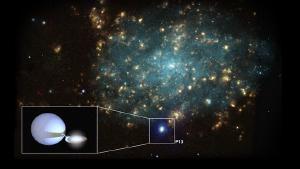Blog
Hungry Hungry Hippo
13 October 2014
 X-ray (NASA/CXC/Univ of Strasbourg/M. Pakull et al); Optical (ESO/VLT/Univ of Strasbourg/M. Pakull et al); H-alpha (NOAO/AURA/NSF/CTIO 1.5m)
X-ray (NASA/CXC/Univ of Strasbourg/M. Pakull et al); Optical (ESO/VLT/Univ of Strasbourg/M. Pakull et al); H-alpha (NOAO/AURA/NSF/CTIO 1.5m)In an earlier post I talked about ultraluminous x-ray sources, and how they are typically powered by stellar-mass black holes. The source of these intense x-rays is the superheated material surrounding the black hole. By observing the intensity of the x-rays, we can get a handle on just how much mass a black hole is actively accumulating. The x-ray intensity has also been used as a measure of the black hole’s mass, since there is a rough limit to just how much matter a black hole of a given size can accrete. It’s known as the Eddington limit, but as we’ve seen, that limit isn’t absolute.
The basic idea of the Eddington limit is that the very x-rays produced as a black hole accretes matter also work to prevent matter from being accreted. That’s because the emitted light can exert an outward pressure on the infalling matter, thus reducing the amount that reaches the black hole. At some point the intensity of light would be so great that the surrounding matter would be pushed away from the black hole, preventing matter from accreting altogether. This is what’s known as the Eddington limit.
Which brings us to the case of a black hole known as P13. Like most ultraluminous black holes, P13 has a binary companion, in this case a blue supergiant of about 20 solar masses. The black hole captures material from its companion, which is how it gets the matter it accretes. As the black hole and star orbit each other, their light is Doppler shifted due to their orbital motion. From this we know that the two orbit each other with a period of about 64 days.
That information by itself isn’t enough to determine the mass of the black hole, but in a recent paper in Nature, new data is used to determine the mass of P13.1 As the authors point out, the intense x-rays of the black hole heat the facing side of the companion star. This affects the spectrum emitted by the star, which can be observed. My modeling the x-ray heating and matching it to the observed spectrum, the team could get a measure of their distance of separation. From this they determined the mass of P13 to be less than 15 solar masses.
That’s a great result by itself, but what’s surprising is that this is much smaller than the value expected given its luminosity. According to the Eddington limit, a black hole of this size shouldn’t be nearly so bright. Given past violations of the Eddington limit, that might not be too surprising, but the rate of accretion is huge. This black hole is eating an Earth’s worth of mass every three years.
Just how that occurs is not clear. What is clear is that P13 is a hungry hippo indeed.
Motch, C., et al. “A mass of less than 15 solar masses for the black hole in an ultraluminous X-ray source.” Nature 514.7521 (2014): 198-201. ↩︎